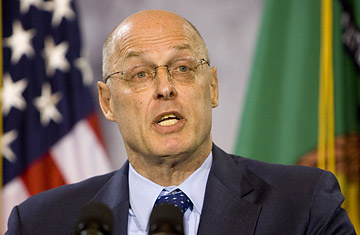
Treasury Secretary Henry Paulson announces sweeping changes in the financial regulatory system at the Treasury Department.
Is George W. Bush the new FDR? Well, not exactly.
Bush's Treasury Department unveiled proposed changes in the regulatory scope and power of America's corporate and financial overseers Monday that are beyond anything seen since Roosevelt warned Americans beset by failed banks, food lines and 30% unemployment that they had nothing to fear but fear itself. With today's markets jittery and average homeowners facing increasingly tight times as inflation and mortgage payments rise while home values fall, the Bush Administration is casting itself as a regulatory savior bringing some rationality to a dangerously complex and outdated system.
But Democrats are skeptical that the Administration has finally seen the merits of tighter financial oversight. They say Bush's move, while a good start and potentially capable of getting bipartisan support, fits more closely with the pattern he has established since they took over Congress in 2006: a near freeze on new regulations unless and until the legislative or scientific ground gives way beneath him, at which point he launches savvy, preemptive moves to limit the scope of any new regulatory power.
Something in between is probably closest to the truth.
Just before the Easter break in mid-March, Barney Frank, head of the House financial services committee, announced a series of initiatives to restructure financial regulation, create a new financial services uber-regulator and stiffen restrictions on Wall Street's complex financial tools for issuing credit and raising capital. His proposals had strong backing in the Democratic caucus, according to Brendan Daly, spokesman for House Speaker Nancy Pelosi. What's more, in what Democrats say is a sign of the changing environment in the wake of the Bear Stearns collapse, the Senate this week will take up a new housing bill that was previously blocked by Republicans. Treasury's move, say the Democrats, was driven by the new momentum for regulation instigated by Frank and other Democrats. "Any fair reading of the situation would have to conclude that," says Jim Manley, spokesman for Democratic Senate Majority Leader Harry Reid.
But Bush's response was not "like pulling a rabbit out of a hat," as White House press secretary Dana Perino put it on Monday. It is actually an adapted version of Treasury Secretary Paulson's year-long effort to recast and consolidate American financial regulation to keep it competitive with foreign markets. It codifies the ad hoc powers of market stabilization the Federal Reserve has used to calm the waters since the collapse of Bear Stearns in March. It establishes an authority with control over financial institutions' behavior but leaves open just how much power it would have to enforce standards. It would split the SEC's regulatory power between that new group and another authority focused on non-finance corporations that would have no new powers.
The plan has received a relatively positive response from Democrats in Congress. "This is a good effort," said Steve Adamske, Frank's spokesman. "We have some disagreements, but they are moving in a direction that we think is positive." Daly, Pelosi's spokesman, said her office has concluded that Paulson's plan is "probably a decent first step, but there's just a lot of devils in the details." In short, the Treasury plan is seen as an opening bid in negotiations with Congress over just how far the new regulatory power will extend. And by showing at least an appearance of good will in the effort to do so, Bush may bring to the table Democrats who otherwise might want to go to war over this issue.
Many Democrats still worry that the Treasury plan could prove a preemptive anti-regulatory trap — hardly the first time Bush has pulled off such a gambit. On fuel efficiency standards, Bush and the auto industry insisted on holding out against tough new restrictions until it became clear that the House and Senate could produce a veto-proof majority. At that point, Bush and the industry backed lesser standards, which eventually became law. More recently, Bush intervened in mid-March to soften new anti-ozone regulations after the EPA had concluded that tough new standards were necessary.
The White House insists that rather than a slowdown in regulation, there has been an uptick in the last few years. Tony Fratto, a White House spokesman, cites as support a recent Heritage study that shows increased regulatory activity. In addition, Bush has been responsible for some important structural changes that have received little attention. In early 2007, for example, he issued an executive order placing "regulatory policy officers" at every department and agency, answerable to the White House on matters of implementing regulation.
Lost in the debate over how much regulation to impose is what if any effect the Treasury plan might have on the current crisis. The simple answer is none. The Treasury department says some modest short-term proposals in the plan can be implemented right away, but any of the larger reorganizing efforts, including the creation of the new regulatory bodies, are likely to take three to eight years to make it through Congress and into action.
